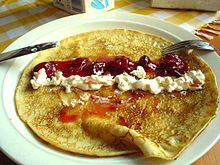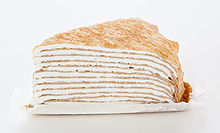- Crêpe
-
A crêpe or crepe (English pronunciation: /ˈkreɪp/,[1] French: [kʁɛp] (
 listen)), is a type of very thin pancake, usually made from wheat flour (crêpes de Froment) or buckwheat flour (galettes). The word is of French origin, deriving from the Latin crispa, meaning "curled". While crêpes originate from Brittany, a region in the northwest of France, their consumption is widespread in France and they are considered a national dish. In Brittany, crêpes are traditionally served with cider. Crêpes are served with a variety of fillings, from the most simple with only sugar to flambéed crêpes Suzette or elaborate savoury fillings.
listen)), is a type of very thin pancake, usually made from wheat flour (crêpes de Froment) or buckwheat flour (galettes). The word is of French origin, deriving from the Latin crispa, meaning "curled". While crêpes originate from Brittany, a region in the northwest of France, their consumption is widespread in France and they are considered a national dish. In Brittany, crêpes are traditionally served with cider. Crêpes are served with a variety of fillings, from the most simple with only sugar to flambéed crêpes Suzette or elaborate savoury fillings.Contents
Preparation
Crêpes are made by pouring a thin liquid batter onto a hot frying pan or flat circular hot plate, often with a trace of butter on the pan's surface. The batter is spread evenly over the cooking surface of the pan or plate either by tilting the pan or by distributing the batter with an offset spatula. There are also specially designed crêpe makers with a heatable circular surface that can be dipped in the batter and quickly pulled out to produce an ideal thickness and evenness of cooking. A cooked crêpe is a very thin pancake.
Common savoury fillings for crêpes served for lunch or dinner are cheese, ham, and eggs, ratatouille, mushrooms, artichoke (in certain regions), and various meat products.
When sweet, they can be eaten as part of breakfast or as a dessert. They can be filled and topped with various sweet toppings, often including Nutella spread, preserves, sugar (granulated or powdered), maple syrup, lemon juice, whipped cream, fruit spreads, custard, and sliced soft fruits or confiture.
Types and special crêpes
Crêpes are especially popular throughout France. The common ingredients include flour, eggs, milk, butter, and a pinch of salt. Crêpes are usually of two types: sweet crêpes (crêpes sucrées) made with wheat flour and slightly sweetened; and savoury galettes (crêpes salées) made with buckwheat flour and unsweetened. The name "galette" came from the French word galet ("pebble"), since the first gallettes were made on a large pebble heated in a fire. Batter made from buckwheat flour is gluten-free, which makes it possible for people who have a gluten allergy or intolerance to eat this type of crêpe.[citation needed]
Mille crêpe is a French cake made of many crêpe layers. The word mille means "a thousand", implying the many layers of crêpe.[2]
Another standard French and Belgian crêpe is the crêpe Suzette, a crêpe with lightly grated orange peel and liqueur (usually Grand Marnier) which is subsequently lit upon presentation.[3]
Cherry Kijafa Crêpes are also often common and are made with a traditional crêpe base, but filled with cherries simmered in a Kijafa wine sauce.[4]
Some chefs insist that Beef Wellington include a crêpe, wrapping the coated meat to retain moisture, thereby preventing the pastry from going soggy.[citation needed]
A common recipe practiced among bodybuilders is what is called a "bodybuilder's crêpe", made with whey protein powder, flavoring, egg white, and other ingredients such as cottage cheese, oats, and peanut butter. They are prepared the same way as normal crêpes are, but can sometimes cook much faster.[clarification needed][citation needed]
Crêperies
A crêperie may be a takeaway restaurant or stall, serving crêpes as a form of fast food or street food, or may be a more formal sit-down restaurant or café.
Crêperies are typical of Brittany in France; however, crêperies can be found throughout France and in many other countries.
Because a crêpe may be served as both a main meal or a dessert, crêperies may be quite diverse in their selection and may offer other baked goods such as baguettes. They may also serve coffee, tea, buttermilk and cider (a popular drink to accompany crêpes).
In other countries
In Swedish, a crêpe is called Pannkaka, in Dutch a pannenkoek or Flensjes, and in Afrikaans a pannekoek, which is usually served with cinnamon sugar. In Italy, crêpes are called crespella. In the Spanish regions of Galicia and Asturias they are traditionally served at carnivals. In Galicia they're called filloas, and may also be made with pork blood instead of milk. In Asturias they are called fayueles or frixuelos, and in Turkey, "Akıtma".
In areas of Eastern Europe formerly belonging to the Austro-Hungarian empire, there is a thin pancake comparable to a crêpe that in Austro-Bavarian is called Palatschinken or Omletten; in Hungarian: palacsinta; and in Bosnian, Serbian, Bulgarian, Macedonian, Montenegrin, Czech, Croatian and Slovene: palačinka; in Slovak: palacinka. In the Balkan region such as the countries of Albania, Bosnia, Croatia, Macedonia, Montenegro, and Serbia, palačinka or palaçinka may be eaten with fruit jam, quark cheese, sugar, honey, or the hazelnut-chocolate cream Nutella. In Ashkenazi Jewish cuisine, there is a similar dish known as the blintz. The Oxford English Dictionary derives the German and Slavic words from the Hungarians palacsinta, which it derives from the Romanian plăcintă ("pie, pancake"), which comes in turn from classical Latin placenta ("small flat cake"). In Chile and Argentina they are called panqueques and are often eaten with dulce de leche (known in English as "milk caramel").
The names for thin crêpes in other parts of Europe are:
- Albanian: krep, palaçinka
- Bosnian: palačinke
- Bulgarian: палачинка
- Czech: palačinka
- Croatian: palačinka
- Faroese: pannukaka
- Finnish: ohukainen, also lätty, lettu or räiskäle
- Galician: filloa or freixó
- Greek: κρέπα krepa
- Hungarian: palacsinta
- Icelandic: pönnukaka
- Italian: crespella
- Latvian: pankūka
- Lithuanian: Lietiniai blynai
- Macedonian: палачинка
- Montenegrin: palačinka
- Norwegian: pannekake
- Polish: naleśniki
- Portuguese: crepe
- Romanian: clătită
- Russian: блины bliny
- Serbian: палачинка/palačinka
- Slovak: palacinka
- Slovene: palačinka
- Swedish: pannkaka/plätt
- Turkish: krep, akıtma
- Ukrainian: млинці mlyntsi
Dishes with similar appearance, taste and preparation methods exist in other parts of the world as well. In India, a crêpe made of fermented rice batter is called a dosa, which often has savoury fillings. Another variety is called Patibola and is sweet in taste due to milk, jaggery or sugar. The injera of Ethiopian/Eritrean/Somali/Yemeni cuisine is often described as a thick crêpe. Also in Somalia, malawax is very similar to a crêpe. It is mostly eaten at breakfast.
Crêpes in culture
In France, crêpes are traditionally served on Candlemas (La Chandeleur), February 2. This day was originally Virgin Mary's Blessing Day but became known as "avec Crêpe Day", referring to the tradition of offering crêpes. The belief was that if you could catch the crêpe with a frying pan after tossing it in the air with your left hand and holding a gold coin in your right hand, you would become rich that year.[5]
See also
References
- ^ Longman Pronunciation Dictionary. 3rd Ed. 2008.
Merriam-Webster Dictionary - ^ Hesser, Amanda (2005-05-15). "The Way We Eat: Building a Modern, Multistoried Dessert". The New York Times. http://www.nytimes.com/2005/05/15/magazine/15FOOD.html.
- ^ Courtine, Robert J. (1984), Larousse gastronomique (French edition), Paris: Librairie Larousse.
- ^ Pancake House (2007). "Cherry Kijafa Crepes"; retrieved from http://www.originalpancakehouse.com/phm_crepes2.html.
- ^ Clay, Xanthe (2007-02-17). "With a flame in your art". London: Telegraph.co.uk. http://www.telegraph.co.uk/foodanddrink/recipes/3336639/With-a-flame-in-your-art.html. Retrieved 2008-04-25.
Pancakes Types Æbleskiver • Appam • Bánh cuốn • Bánh xèo • Bannock • Blintz • Boûkète • Boxty • Cachapa • Chalboribbang • Chapati • Chataamari • Chinese pancake • Crempog • Crêpe • Dosa • Dutch baby pancake • Eggette • Farinata • Flädle • Fläskpannkaka • Funkaso • Galette • Hirayachi • Hortobágyi palacsinta • Injera • Jeon • Jonnycake • Khanom bueang • Memela • Memiljeon • Mofletta • Murtabak • Nalesniki • Oatcake • Okonomiyaki • Palatschinke • Pannekoek • Pathiri • Pesarattu • Ploye • Poffertjes • Potato pancake • Quarkkäulchen • Rava dosa • Roti prata • Sel roti • Socca • Spring pancake • Suncake • Serabi • Thalipeeth • Tlacoyo • Touton • UttapamBrands  Book:Crêpes, pancakes, and waffles ·
Book:Crêpes, pancakes, and waffles ·  Category:Pancakes ·
Category:Pancakes ·  Portal:FoodCategories:
Portal:FoodCategories:- Pancakes
- French cuisine
- Breton cuisine
- Desserts
- Street food
Wikimedia Foundation. 2010.





